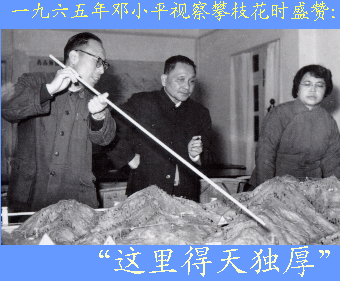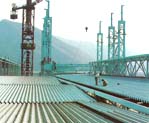|
Tourism info - Panzhihua |
||
To most Chinese, the name Panzhihua only conjures up thoughts of the Panzhihua Iron and Steel (Group) Co, Southwest China's largest steel-making centre and China's largest titanium and vanadium-producing centre. Before the mid-1960s, the present-day Panzhihua was merely a wasteland inhabited by seven families clustered around a ferry. But through the establishment of the Panzhihua Iron and Steel (Group) Co in 1965, it became a booming industrial city. In addition to its metals, Panzhihua, located in the extreme southern part of Sichuan Province and next door to Yunnan Province, is a unique tourist destination worthy of the name. Located in a torrid zone, Panzhihua has an annual average temperature of 20 C. Even in the coldest winter, a sweater is to stay warm enough. The subtropical climate has turned the city into a large "hothouse" where many precious animals and plants co-exist. In many parts of the city, primitive mountains and forests are kept intact. There are 264 kinds of animals, including the lesser panda, as well as 2,300 kinds of plants. The most precious plant is the cycad, a 270-million-year-old rare species living in the same era as the dinosaur. As it survived the destructive glacier of the Quaternary Period, the cycad, which is hailed a living fossil, is of great significance to the study of living things, geography and climate of ancient times, especially the origin of plants, botanists say. More than 1.7 million years ago, because of the glacier of the Quaternary Period, at least one-third of the earth's land mass was covered with snow.
The Longtan Karst Cave, which is open to visitors, has a strong appeal. Marvelling at its caves inside caves, flying waterfalls and fantastic stalactite, visitors would acclaim it as the acme of nature's creation. Occupying less than 0.1 per cent of China's land mass, Panzhihua has 73 kinds of minerals. Its deposits of iron, vanadium and titanium are respectively 20, 67 and 75.5 per cent of China's total. On a global scale, its deposits of titanium are the largest, and those of vanadium are the third-largest in the world. Visitors interested in geology have the luxury to see the world's largest vanadium-titanium mine. Because of geological movements, Panzhihua abounds in crystal, opal, agate, jade and ink stone in its mountain valleys and the alluvium of its river banks. Located at the juncture of the Jinsha and Yalong rivers, two tributaries on the upper reaches of the Yangtze, Panzhihua, which has 90 rivers, abounds in water resources. The construction of the Ertan Hydropower Station in Panzhihua, China's largest hydropower station built in the 20th century, has created a large lake with an area of 101 square kilometres. The lake has five islands and 11 peninsulas. Sailing in a boat, one cannot help but feel the clean water in the lake and the surrounding, majestic-looking mountains with lush, tropical plants like a marvelous, traditional Chinese landscape painting. The station, with a 240-metre-tall dam, the tallest in Asia, and the world's largest underground power house, as well as the lake, are now important tourist destination in Panzhihua. Panzhihua has many hot springs. Its Hongge Hot Spring contains radon, which is rare in other springs in China. The hot spring has a temperature of around 57 C year round. With fluorine, carbonic acid, various minerals and inorganic salts, it has a strong healing effect and is ideal for the winter's holiday visitors. People from 34 of China's 55 ethnic groups can be found in Panzhihua. With a long history and unique folk customs, they give rise to cultural diversity. In addition to its own tourist attractions, Panzhihua sits directly en route to the mysterious Lugu Lake from Sichuan. Heading northwest for about 300 kilometres, tourists from Panzhihua arrive at the lake on the border of Sichuan and Yunnan. Two-thirds of the lake is in Sichuan. The romantic customs of the Mosuo people have turned the lake into a mysterious wonderland for tourists. The Mosuo, believed to be the world's last matriarchal tribe, have preserved their centuries-old matriarchal customs. Mosuo women are the community rulers and family decision-makers. A Mosuo woman can choose to cohabit with any man she falls in love with and give birth to their children without getting married. If she loses interest in her lover, which seldom happens, she is free to choose a new love. The problem hindering its tourism development is inadequate transport facilities. As its airport is under construction, one has to travel 15 hours from Chengdu, the capital of Sichuan Province, to reach the city. |

 Located
in a rift, Panzhihua became a haven to the cycad. A wild cycad forest
covering 1,358 hectares is in Panzhihua's suburbs. China's only State-level
cycad nature reserve, the forest comprises 230,000 wild cycads, believed
to be the world's largest and northernmost wild cycad forest. In the forest,
136,000 are fully-grown cycads and the rest are saplings. Cycads seldom
blossom. But the ones in Panzhihua blossom once every May. As Panzhihua's cycads
hold high international prestige, the Fourth International Seminar on
Cycads was held in Panzhihua in May 1996. With 92 per cent of its land
being mountainous, Panzhihua is referred as a "geological museum." The
city boasts many karst formations. More than 80 karst caves have been
discovered.
Located
in a rift, Panzhihua became a haven to the cycad. A wild cycad forest
covering 1,358 hectares is in Panzhihua's suburbs. China's only State-level
cycad nature reserve, the forest comprises 230,000 wild cycads, believed
to be the world's largest and northernmost wild cycad forest. In the forest,
136,000 are fully-grown cycads and the rest are saplings. Cycads seldom
blossom. But the ones in Panzhihua blossom once every May. As Panzhihua's cycads
hold high international prestige, the Fourth International Seminar on
Cycads was held in Panzhihua in May 1996. With 92 per cent of its land
being mountainous, Panzhihua is referred as a "geological museum." The
city boasts many karst formations. More than 80 karst caves have been
discovered.